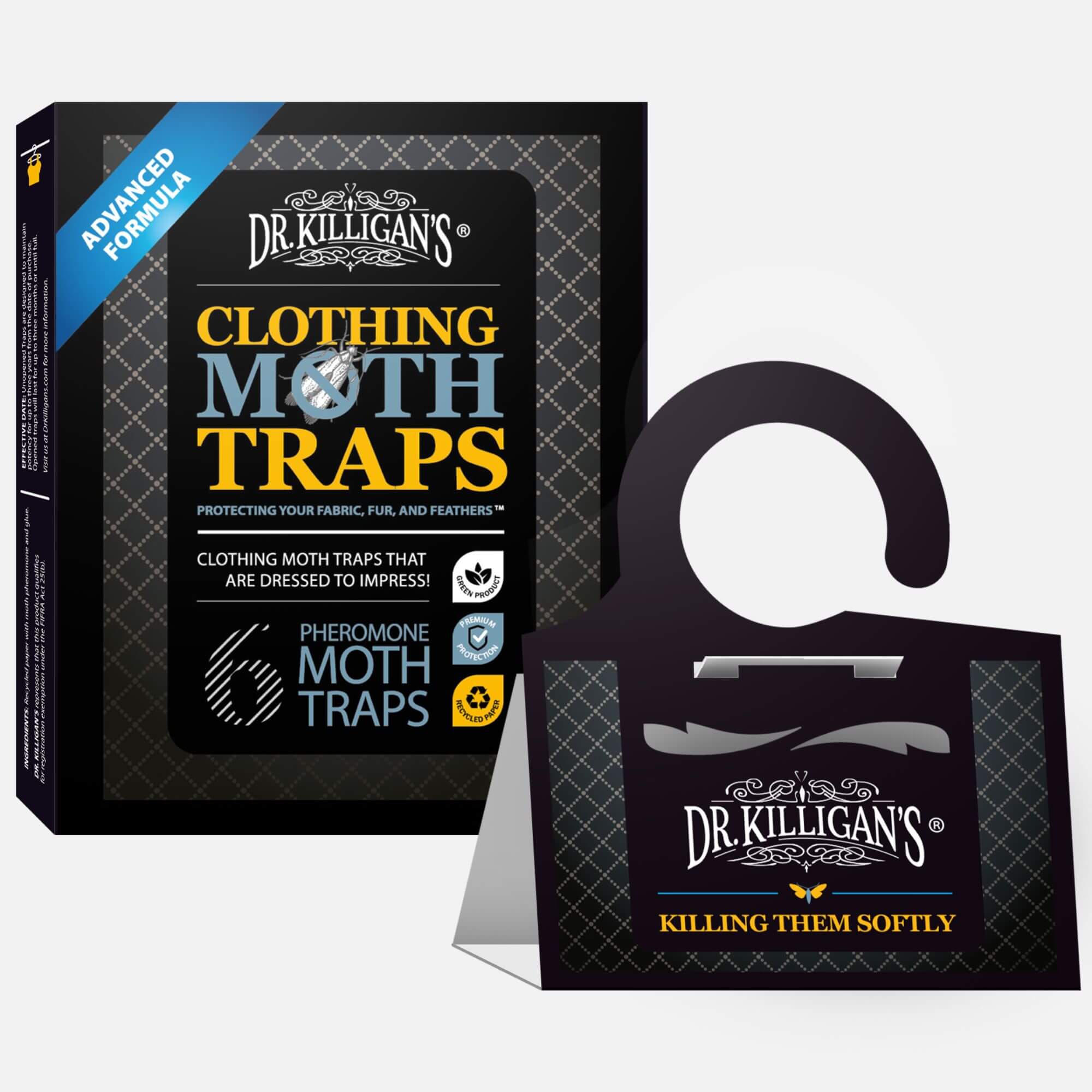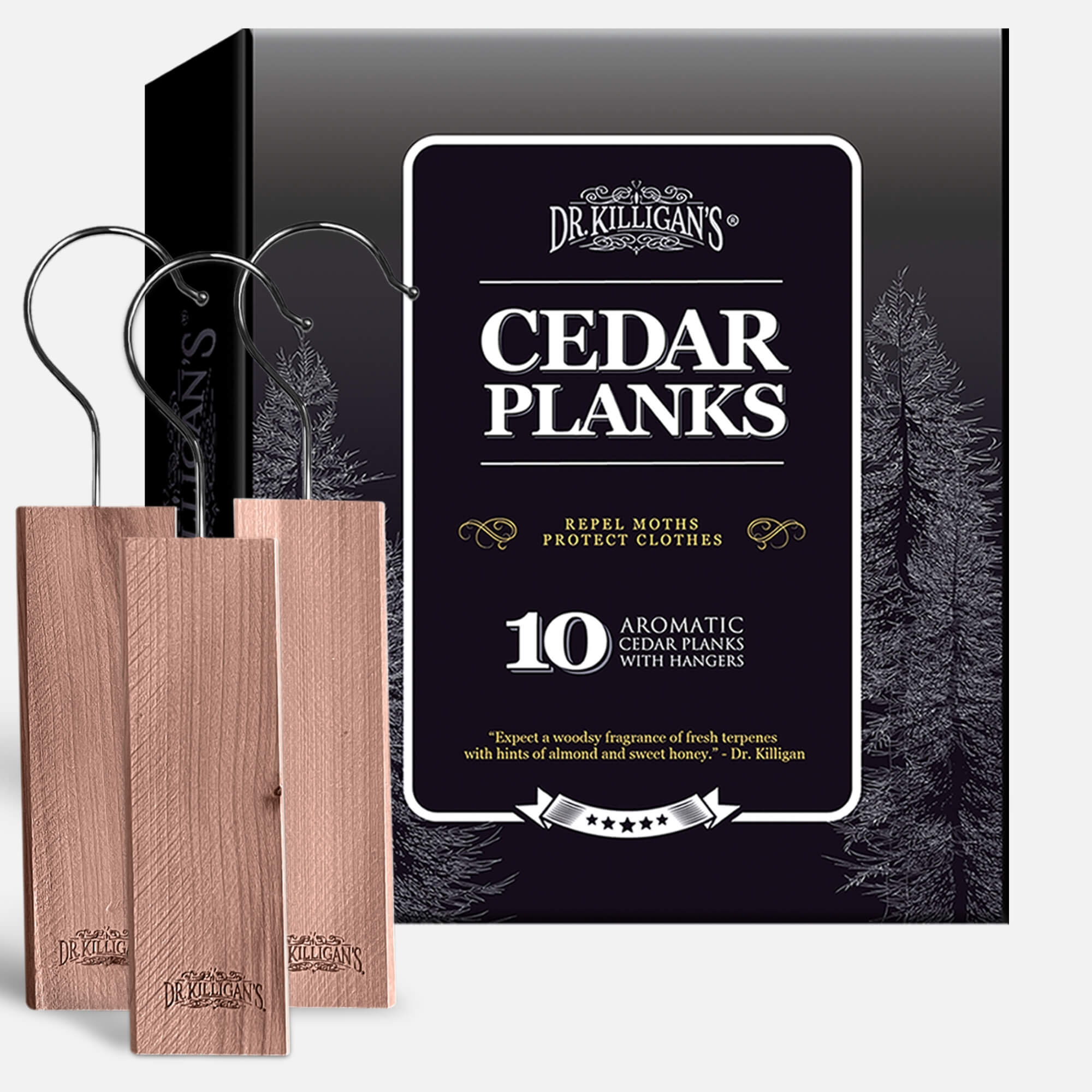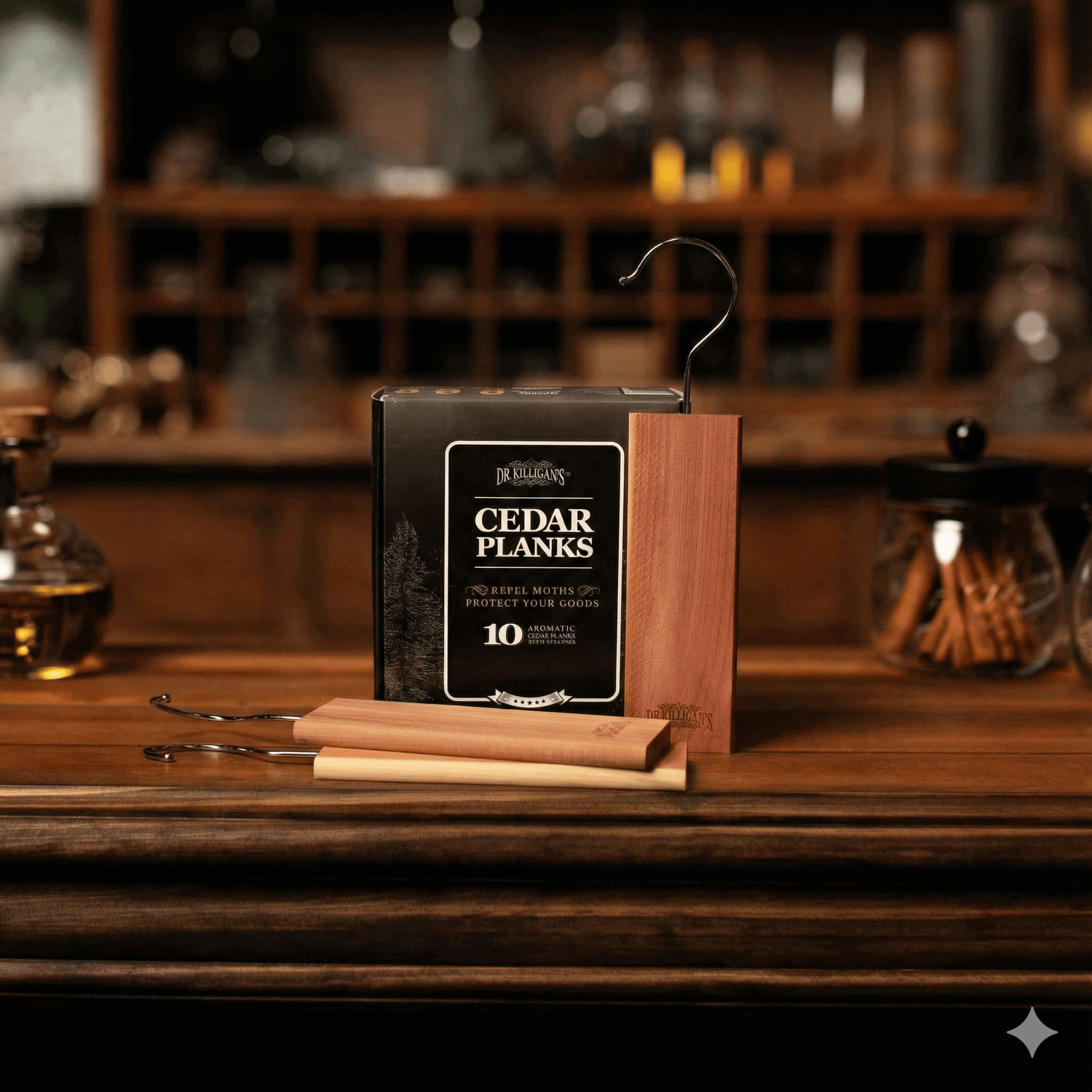Published September 5, 2024 · Updated October 30, 2025
Reviewed by Julie Miller, BA in Language Arts, Editorial Lead, Dr. Killigan’s
TL;DR: Mothballs release toxic fumes from naphthalene or paradichlorobenzene (PDB). Exposure can cause irritation, organ damage and anemia. Use Cedar Planks or Clothing Moth Traps instead.
I slowly lifted up the heavy lid. It creaked, as if in relief. Tattered books, a thin scarlet-red wool blanket and a picture frame—the glass damaged, cracked—lay stacked, one on top of the other. Like neatly pressed crisp garments, the items were carefully placed in a tidy rising tower. As I strained to truly see the dull black-and-white photo of my mentor’s parents, I lost focus. The smell of the mothballs—powerful, overwhelming, intrusive—blurred my vision. I began to cough.
In the late 1800s, mothballs were made exclusively from naphthalene. Inhalation of naphthalene caused skin and eye irritation; gastrointestinal symptoms, such as nausea, vomiting, abdominal cramps and diarrhea; neurologic symptoms, such as confusion, excitement and convulsions; renal problems, such as acute renal shutdown; and hematologic features, such as icterus and severe anemia.
Most modern mothballs no longer contain naphthalene, due to its high flammability and toxicity. However, their replacement—PDB-rich mothballs—are just as toxic, just as dangerous and perhaps just as flammable.
What are mothballs and how do they work?
Mothballs are small, milky-white, harmless-looking clouds of fluff made with either naphthalene or PDB. They don’t “spray” a liquid; they sublime—slowly turning from solid to vapor. In a tightly sealed container (e.g., garment bin or bag), those fumes build up to levels that can kill clothes moths, their larvae and eggs. Labels direct use only in enclosed storage; placing mothballs in open closets, rooms, attics or basements lets fumes escape into living spaces and reduces effectiveness.
(These instructions also inform you that using mothballs as a snake or rodent deterrent is illegal.)
How long are mothballs toxic?
Mothballs stay toxic as long as they’re off-gassing. In a tightly sealed container, the pellets can persist 4–6 weeks or longer, depending on temperature, pellet size and how airtight the container is.

In partially sealed or open spaces, vapors escape into living areas, exposing people and pets to the fumes.
Even after pellets are gone, odor and residues can linger on fabrics and inside storage bins. Garments may hold the smell well beyond the 4–6 week window until they’re aired out, washed or dry-cleaned.
Is it safe to have mothballs in the house?
Though the smell of mothballs may remind you of your grandmother’s attic or that heirloom cedar chest in your great aunt’s spare bedroom, mothballs—especially if they’re the "old fashioned" kind—are not safe. They are all dangerous and can have multiple negative effects. Here are nine documented dangers.

-
Mothballs are poisonous. They are considered carcinogenic. When you inhale the scent of a mothball, you are inhaling the insecticide. When you wear an article of clothing that was stored with mothballs, the toxicity of the mothballs is absorbed through the skin.
-
Mothballs are pesticides. They are commonly 100% made up of naphthalene or paradichlorobenzene, both of which are hazardous to humans.
-
Mothballs contain naphthalene. Naphthalene, an aromatic hydrocarbon found in coal tar or petroleum, has been a mothball-banned ingredient in the European Union since 2008, but is still commonly found (in mothballs) in homes here in the United States. Though toxic, it is used today in the manufacture of plastics, resins, fuels and dyes—specifically PVC, insecticides (insect killing chemicals), dyes, toilet deodorant blocks and phthalic anhydride. Because it is produced when things burn, it is also found in cigarette smoke, car exhaust and smoke from forest fires.
-
Mothballs contain toxins. Mothballs contain PDB, which is also called 1,4-dichlorobenzene. PDB is a toxic chlorinated aromatic hydrocarbon that is used as a fumigant insecticide and repellent. Today, it is commonly used as the only ingredient in mothballs. It is also found in deodorant blocks made for trash cans and toilets.
-
Mothballs release heavier-than-air vapors. These fumes, because of their vapor density, don’t readily dissipate into the atmosphere. Rather, they accumulate along floors or aggregate at the bottom of enclosures, thus posing a higher danger to small children and pets.
-
Mothballs damage the environment. Mothballs contribute to air pollution because the chemicals that make them up—which are solid at room temperature—slowly change to gasses when they are made into round balls, flakes or cakes. These gasses become toxic fumes in the air. They can also contaminate soil and water, as both naphthalene and PDB mothballs leach chemicals into the soil and potentially the groundwater, as rains wash some of the chemicals into storm sewers, wells and waterways.
-
Mothballs harm your pets. As little as one mothball could poison a dog. The toxic dose depends on the size of your pet, the size of mothball, the type of mothball and whether the mothball was ingested, or if the pet was only exposed to the fumes. Though cats are more sensitive to their toxic effects, dogs are more likely to ingest mothballs due to their curious nature.
-
Mothballs can be mistaken for candy. Whether it was a genius marketing strategy or completely accidental, mothballs often look like tasty treats. In fact, there was once a candy deemed ‘the mothball candy’ that was popular in the 19th century and the early 20th century. It is also known as the cream filbert.
- Mothballs can cause liver and kidney damage. Mothballs can make you very sick. This occurs because the poison from the chemicals (either naphthalene or PDB) destroys or changes your red blood cells so that they cannot carry oxygen.
Final word on mothballs
As the wind billowed through the open windows, the toxic fumes were lifted up and away. My eyes cleared. The cough subsided. I felt numb, numb with the knowledge of the dangerous effects of mothballs; My thoughts couldn't escape them. I yearned for these thoughts to, like the wind, billow and pass. They wouldn’t. Ignorance can be bliss. Ignorance can also be cruel. I wasn’t with my mentor when he had passed, but I began to wonder about the levels of toxicity in his body that accumulated over the years—if that had somehow contributed to losing him too soon.

Don’t use mothballs in your home. Keep Clothing Moth Traps in your closets and drawers and master your mind with how-to-get-rid-of-clothing-moths understanding. Hang a few Cedar Planks into your wardrobe. Cedar’s natural moth-repelling magic protects fabrics like wool and leather, keeping your clothes fresh and moth-free for months.
Before storing, dry clean, freeze or wash your clothing-moth-attractive clothes in hot water to ensure that any moths, larvae or eggs are killed. (I recommend storing these garments in non-reactive plastic or, even better, durable, breathable, plastic-free bags such as those made from PEVA vinyl or non-woven fabrics). Vacuum your home frequently. Know the facts when it comes to pest control. Together, let’s do all that we can to keep your home toxic-free.















